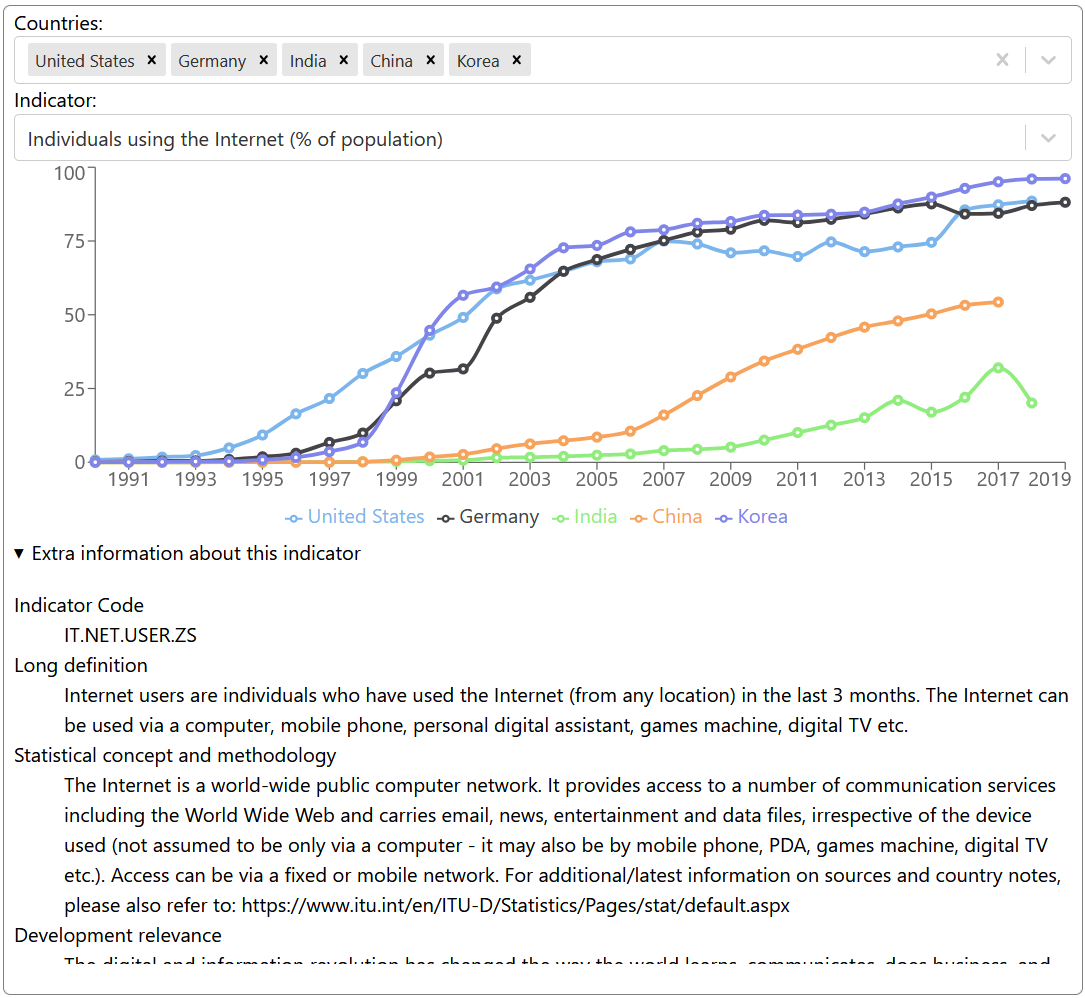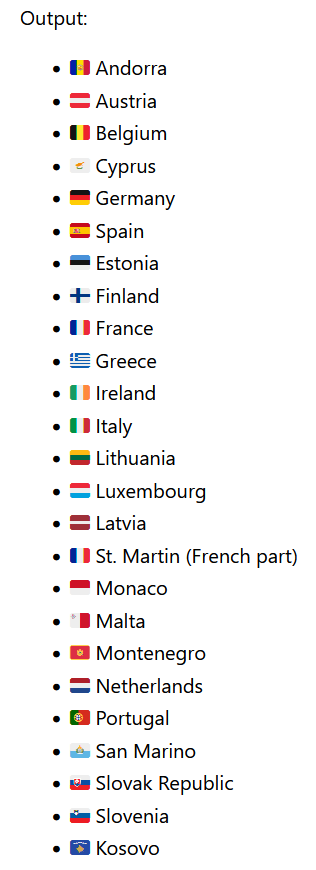1
2
3
4
5
6
7
8
9
10
11
12
13
14
15
16
17
18
19
20
21
22
23
24
25
26
27
28
29
30
31
32
33
34
35
36
37
38
39
40
41
42
43
44
45
46
47
48
49
50
51
52
53
54
55
56
57
58
59
60
61
62
63
64
65
66
67
68
69
70
71
72
73
74
75
76
77
78
79
80
81
82
83
84
85
86
87
88
89
90
91
92
| [
{
"indicator_code": "SL.UEM.BASC.FE.ZS",
"topic": "Social Protection & Labor: Unemployment",
"indicator_name": "Unemployment with basic education, female (% of female labor force with basic education)",
"short_definition": null,
"long_definition": "The percentage of the labor force with a basic level of education who are unemployed. Basic education comprises primary education or lower secondary education according to the International Standard Classification of Education 2011 (ISCED 2011).",
"statistical_concept_and_methodology": null,
"development_relevance": null
},
{
"indicator_code": "SL.UEM.INTM.FE.ZS",
"topic": "Social Protection & Labor: Unemployment",
"indicator_name": "Unemployment with intermediate education, female (% of female labor force with intermediate education)",
"short_definition": null,
"long_definition": "The percentage of the labor force with an intermediate level of education who are unemployed. Intermediate education comprises upper secondary or post-secondary non tertiary education according to the International Standard Classification of Education 2011 (ISCED 2011).",
"statistical_concept_and_methodology": null,
"development_relevance": null
},
{
"indicator_code": "SL.TLF.BASC.FE.ZS",
"topic": "Social Protection & Labor: Labor force structure",
"indicator_name": "Labor force with basic education, female (% of female working-age population with basic education)",
"short_definition": null,
"long_definition": "The percentage of the working age population with a basic level of education who are in the labor force. Basic education comprises primary education or lower secondary education according to the International Standard Classification of Education 2011 (ISCED 2011).",
"statistical_concept_and_methodology": null,
"development_relevance": null
},
{
"indicator_code": "SL.TLF.INTM.FE.ZS",
"topic": "Social Protection & Labor: Labor force structure",
"indicator_name": "Labor force with intermediate education, female (% of female working-age population with intermediate education)",
"short_definition": null,
"long_definition": "The percentage of the working age population with an intermediate level of education who are in the labor force. Intermediate education comprises upper secondary or post-secondary non tertiary education according to the International Standard Classification of Education 2011 (ISCED 2011).",
"statistical_concept_and_methodology": null,
"development_relevance": null
},
{
"indicator_code": "SL.UEM.ADVN.FE.ZS",
"topic": "Social Protection & Labor: Unemployment",
"indicator_name": "Unemployment with advanced education, female (% of female labor force with advanced education)",
"short_definition": null,
"long_definition": "The percentage of the labor force with an advanced level of education who are unemployed. Advanced education comprises short-cycle tertiary education, a bachelor’s degree or equivalent education level, a master’s degree or equivalent education level, or doctoral degree or equivalent education level according to the International Standard Classification of Education 2011 (ISCED 2011).",
"statistical_concept_and_methodology": null,
"development_relevance": null
},
{
"indicator_code": "SL.TLF.ADVN.FE.ZS",
"topic": "Social Protection & Labor: Labor force structure",
"indicator_name": "Labor force with advanced education, female (% of female working-age population with advanced education)",
"short_definition": null,
"long_definition": "The percentage of the working age population with an advanced level of education who are in the labor force. Advanced education comprises short-cycle tertiary education, a bachelor’s degree or equivalent education level, a master’s degree or equivalent education level, or doctoral degree or equivalent education level according to the International Standard Classification of Education 2011 (ISCED 2011).",
"statistical_concept_and_methodology": null,
"development_relevance": null
},
{
"indicator_code": "SE.PRE.TCAQ.FE.ZS",
"topic": "Education: Inputs",
"indicator_name": "Trained teachers in preprimary education, female (% of female teachers)",
"short_definition": null,
"long_definition": "Trained teachers in preprimary education are the percentage of preprimary school teachers who have received the minimum organized teacher training (pre-service or in-service) required for teaching in a given country.",
"statistical_concept_and_methodology": "Share of trained teachers is calculated by dividing the number of trained teachers of the specified level of education by total number of teachers at the same level of education, and multiplying by 100. \n\nData on education are collected by the UNESCO Institute for Statistics from official responses to its annual education survey. All the data are mapped to the International Standard Classification of Education (ISCED) to ensure the comparability of education programs at the international level. The current version was formally adopted by UNESCO Member States in 2011. \n\nThe reference years reflect the school year for which the data are presented. In some countries the school year spans two calendar years (for example, from September 2010 to June 2011); in these cases the reference year refers to the year in which the school year ended (2011 in the example).",
"development_relevance": "Trained teachers refer to teaching force with the necessary pedagogical skills to teach and use teaching materials in an effective manner. The share of trained teachers reveals a country's commitment to investing in the development of its human capital engaged in teaching.\n\nTeachers are important resource, especially for children who are the first-generation of receiving education in their families and heavily rely on teachers in acquiring basic literacy skills. However, rapid increase in enrollments may cause the shortage of trained teachers. Education finance is a key for appropriate teacher allocations, since teacher salaries account for a large share of education budgets. The shortage of trained teacher may result in low qualified teachers in more disadvantaged area."
},
{
"indicator_code": "SE.PRM.TCAQ.FE.ZS",
"topic": "Education: Inputs",
"indicator_name": "Trained teachers in primary education, female (% of female teachers)",
"short_definition": null,
"long_definition": "Trained teachers in primary education are the percentage of primary school teachers who have received the minimum organized teacher training (pre-service or in-service) required for teaching in a given country.",
"statistical_concept_and_methodology": "Share of trained teachers is calculated by dividing the number of trained teachers of the specified level of education by total number of teachers at the same level of education, and multiplying by 100. \n\nData on education are collected by the UNESCO Institute for Statistics from official responses to its annual education survey. All the data are mapped to the International Standard Classification of Education (ISCED) to ensure the comparability of education programs at the international level. The current version was formally adopted by UNESCO Member States in 2011. \n\nThe reference years reflect the school year for which the data are presented. In some countries the school year spans two calendar years (for example, from September 2010 to June 2011); in these cases the reference year refers to the year in which the school year ended (2011 in the example).",
"development_relevance": "Trained teachers refer to teaching force with the necessary pedagogical skills to teach and use teaching materials in an effective manner. The share of trained teachers reveals a country's commitment to investing in the development of its human capital engaged in teaching.\n\nTeachers are important resource, especially for children who are the first-generation of receiving education in their families and heavily rely on teachers in acquiring basic literacy skills. However, rapid increase in enrollments may cause the shortage of trained teachers. Education finance is a key for appropriate teacher allocations, since teacher salaries account for a large share of education budgets. The shortage of trained teacher may result in low qualified teachers in more disadvantaged area."
},
{
"indicator_code": "SE.SEC.TCAQ.FE.ZS",
"topic": "Education: Inputs",
"indicator_name": "Trained teachers in secondary education, female (% of female teachers)",
"short_definition": null,
"long_definition": "Trained teachers in secondary education are the percentage of secondary school teachers who have received the minimum organized teacher training (pre-service or in-service) required for teaching in a given country.",
"statistical_concept_and_methodology": "Share of trained teachers is calculated by dividing the number of trained teachers of the specified level of education by total number of teachers at the same level of education, and multiplying by 100. \n\nData on education are collected by the UNESCO Institute for Statistics from official responses to its annual education survey. All the data are mapped to the International Standard Classification of Education (ISCED) to ensure the comparability of education programs at the international level. The current version was formally adopted by UNESCO Member States in 2011. \n\nThe reference years reflect the school year for which the data are presented. In some countries the school year spans two calendar years (for example, from September 2010 to June 2011); in these cases the reference year refers to the year in which the school year ended (2011 in the example).",
"development_relevance": "Trained teachers refer to teaching force with the necessary pedagogical skills to teach and use teaching materials in an effective manner. The share of trained teachers reveals a country's commitment to investing in the development of its human capital engaged in teaching.\n\nTeachers are important resource, especially for children who are the first-generation of receiving education in their families and heavily rely on teachers in acquiring basic literacy skills. However, rapid increase in enrollments may cause the shortage of trained teachers. Education finance is a key for appropriate teacher allocations, since teacher salaries account for a large share of education budgets. The shortage of trained teacher may result in low qualified teachers in more disadvantaged area."
},
{
"indicator_code": "SE.SEC.TCAQ.LO.FE.ZS",
"topic": "Education: Inputs",
"indicator_name": "Trained teachers in lower secondary education, female (% of female teachers)",
"short_definition": null,
"long_definition": "Trained teachers in lower secondary education are the percentage of lower secondary school teachers who have received the minimum organized teacher training (pre-service or in-service) required for teaching in a given country.",
"statistical_concept_and_methodology": "Share of trained teachers is calculated by dividing the number of trained teachers of the specified level of education by total number of teachers at the same level of education, and multiplying by 100. \n\nData on education are collected by the UNESCO Institute for Statistics from official responses to its annual education survey. All the data are mapped to the International Standard Classification of Education (ISCED) to ensure the comparability of education programs at the international level. The current version was formally adopted by UNESCO Member States in 2011. \n\nThe reference years reflect the school year for which the data are presented. In some countries the school year spans two calendar years (for example, from September 2010 to June 2011); in these cases the reference year refers to the year in which the school year ended (2011 in the example).",
"development_relevance": "Trained teachers refer to teaching force with the necessary pedagogical skills to teach and use teaching materials in an effective manner. The share of trained teachers reveals a country's commitment to investing in the development of its human capital engaged in teaching.\n\nTeachers are important resource, especially for children who are the first-generation of receiving education in their families and heavily rely on teachers in acquiring basic literacy skills. However, rapid increase in enrollments may cause the shortage of trained teachers. Education finance is a key for appropriate teacher allocations, since teacher salaries account for a large share of education budgets. The shortage of trained teacher may result in low qualified teachers in more disadvantaged area."
}
]
|




